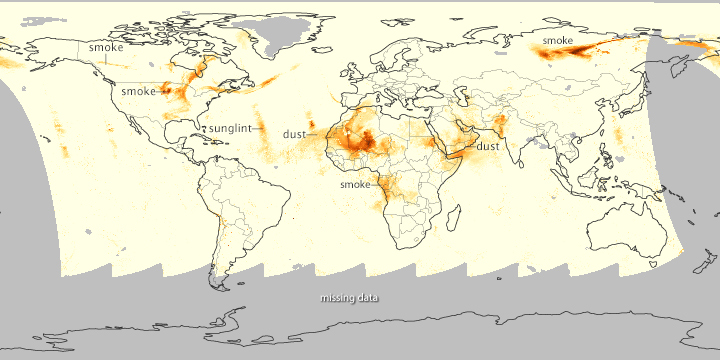Dust In Your Eye? Particulate Matter Seen from Space

Is it dusty in here? A recent map of small airborne particles called aerosols captures dust on the Arabian Peninsula and smoke in Russia and the United States.
Aerosols are tiny particles, either solid or liquid, in the atmosphere. They come from smoke, from volcanic eruptions and dust storms, and from the burning of fossil fuels. Unlike the carbon dioxide released from burning oil and coal, however, aerosols tend to cool the atmosphere instead of warming it, according to NASA Langley Research Center.
This aerosol map is from data collected July 19 by the Suomi NPP satellite, according to NASA's Earth Observatory. The darker the orange, the denser the aerosol concentration.
Along the Arabian Peninsula and over the Sahara Desert of Africa, dense concentrations of aerosols come from sandy dust kicked up by winds. Some of this dust reaches out over the Atlantic Ocean. Dust plumes frequently blow across the Atlantic, often reaching all the way to North America.
In Russia, a dark plume of aerosols marks a fire in Siberia. Fires also kick up aerosols in northwest Canada and over the Midwestern United States.
Aerosols also form in forests, where gases and particles released by plants mix. A 2013 study found that this "plant pollution" might help cool the climate by boosting cloud formation — though the effect offsets only about 1 percent of global warming caused by human activities.
Editor's Note: If you have an amazing nature or general science photo you'd like to share for a possible story or image gallery, please contact managing editor Jeanna Bryner at LSphotos@livescience.com.
Sign up for the Live Science daily newsletter now
Get the world’s most fascinating discoveries delivered straight to your inbox.
Follow Stephanie Pappas on Twitter and Google+. Follow us @livescience, Facebook & Google+. Original article on Live Science.

Stephanie Pappas is a contributing writer for Live Science, covering topics ranging from geoscience to archaeology to the human brain and behavior. She was previously a senior writer for Live Science but is now a freelancer based in Denver, Colorado, and regularly contributes to Scientific American and The Monitor, the monthly magazine of the American Psychological Association. Stephanie received a bachelor's degree in psychology from the University of South Carolina and a graduate certificate in science communication from the University of California, Santa Cruz.










